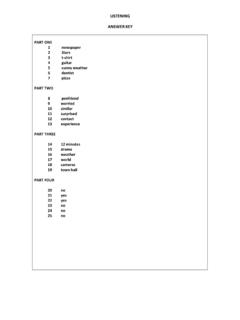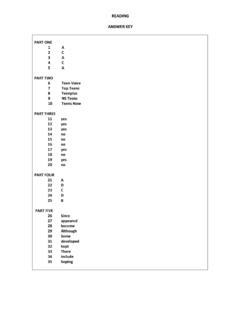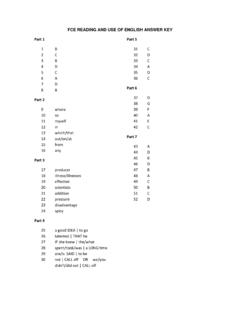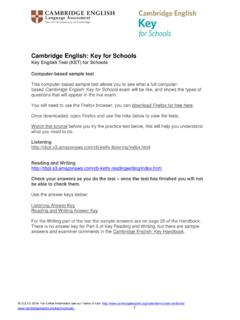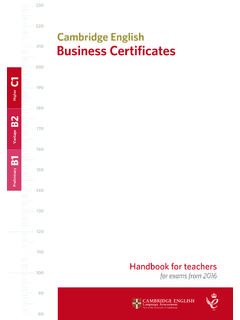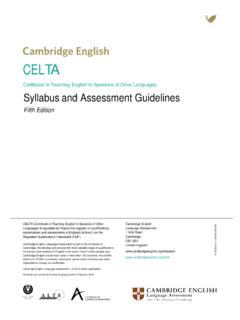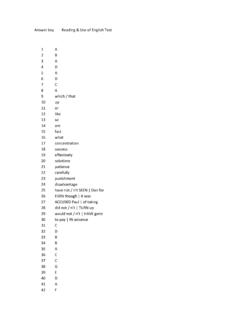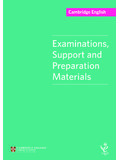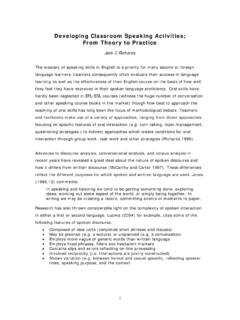Transcription of IELTS Speaking Part 3 – teacher’s notes
1 IELTS Speaking part 3 teacher's notes Description An activity to practise asking and answering questions on typical part 3 topics and which practises using expressions to give full and discursive answers Time required: 60 + minutes Additional activity worksheets 1-4 (one copy of each unless you have more materials than 16 students in a class, in which case two copies each). required: language worksheet, cut-up expressions (enough for at last three for each student). Aims: to consider the types of question that may be asked in part 3. to practise asking and answering these questions 3. to study and use expressions that help make answers full and cohesive Procedure 1. Review what part 3 of the Speaking test involves and what the assessment criteria are (see overview activity). 2. Remind students that part 3 follows on from part 2. Hand out the sample part 3 and explain that in part 2 students had to describe something they own which is very important to them.
2 Elicit a few ideas from the class of what you could talk about in part 3 to answer these questions. 3. Elicit how long the students think that their answers will be. Encourage lengthy (but natural). responses. Put students into pairs to ask and answer the questions, with students swapping roles after the first two questions. 4. Explain that students are going to think of some interesting questions on topics which might be used in part 3. Divide students into four groups, or more if there are more than four students in a group. 5. Hand out worksheets 1 4 to the groups above, making sure each group has a different worksheet. Give students 15 minutes to think of as many interesting questions as possible. Monitor and check their questions for accuracy and legibility. 6. Collect in worksheets 1 4. Hand out the language worksheet. Students match the expressions. While they are doing this, cut worksheets 1 4 up into their different topics with the questions.
3 Photocopy if necessary so that there is one for each student. 7. In full class, check answers, meaning and use of expressions. Hand out the key and go through the examples of the expressions in the context of this part 3. 8. Drill the pronunciation of the expressions and allow a couple of minutes of individual practice. 9. Do a few minutes of controlled practice of the expressions by giving the first few words of an expression and asking students to complete it. UCLES 2009. This material may be photocopied (without alteration) and distributed for classroom use provided no charge is made. For further information see our Terms and Conditions 10. Divide students into new pairs. Hand out one topic with questions to each student and three of the expressions to each student. 11. One student is the examiner and asks the questions and the other is the candidate who answers the questions. Explain that this part of the test lasts 4 5 minutes and so the answers have to be fairly detailed.
4 Students have to answer the questions as fully as possible and use all their expressions in the 4 5 minutes. Encourage them to use more that they remember from the sheet if possible. 12. Start the activity, time 4 5 minutes, monitor and note good examples of language, and language for a correction slot, on the board. 13. The students change roles and use the other topic with questions. Repeat steps 10 and 11. 14. Pairs exchange topics with questions with another pair and repeat the activity as time allows. 15. Go through the examples of good language and do a correction slot on the board. UCLES 2009. This material may be photocopied (without alteration) and distributed for classroom use provided no charge is made. For further information see our Terms and Conditions IELTS Speaking part 3 answer keys Key to Language Worksheet It has a good/bad influence on . It can have a positive/negative/bad effect on . - Advertising can have a negative effect on teenagers as it makes them think they've got to keep up with the latest fashions, no matter what the cost.
5 - Advertising has a bad influence on teenagers as it makes them think they've got to keep up with the latest fashions, no matter what the cost. The root of the problem is . It all stems from . - Many people today love to shop, and end up in debt. The root of the problem is that in today's society, social status is shown by possessions. - Many people today love to shop, and end up in debt. It all stems from the fact that in today's society, social status is shown by possessions. The main reason for that is/was . That is mainly because . - I remember when I was a child, my parents' most important possession was the TV. The main reason for that was that it was the only form of entertainment they had in the house. - I remember when I was a child, my parents' most important possession was the TV. That was mainly because it was the only form of entertainment they had in the house. It can cause . It leads to . - There can be a lot of competition between children at school to have the latest gadget.
6 It can cause a lot of bullying. - There can be a lot of competition between children at school to have the latest gadget. It leads to a lot of bullying. All in all . Overall . - All in all, advertising is a powerful tool. - Overall, advertising is a powerful tool. Many people claim that . It is often said that . - Many people claim that advertising doesn't affect consumers. - It is often said that advertising doesn't affect consumers. UCLES 2009. This material may be photocopied (without alteration) and distributed for classroom use provided no charge is made. For further information see our Terms and Conditions One possible solution is . We could solve the problem by . - People are spending too much and getting into debt. One possible solution is to ban the use of credit cards. - People are spending too much and getting into debt. We could solve the problem by banning credit cards. Consequently . As a result . - My family didn't have much money when I was a child.
7 Consequently, I really valued every present I. was given. - My family didn't have much money when I was a child. As a result, I really valued every present I was given. I would suggest ing I think it's a good idea to . - To stop children from demanding expensive toys, I would suggest banning all adverts during children's TV programmes. - To stop children from demanding expensive toys, I think it's a good idea to ban all adverts during children's TV programmes. There's more than one reason why . I think that there are a few reasons why . - There's more than one reason why women love to buy fashionable clothes: advertising, friends, TV. and magazines, the image of the perfect woman and so on. - I think that there are a few reasons why women love to buy fashionable clothes: advertising, friends, TV and magazines, the image of the perfect woman and so on. Personally, I think . As I see it . - Personally, I think that fashion is a waste of time and money.
8 - As I see it, fashion is a waste of time and money. You have to bear in mind . You have to take into account . - You have to bear in mind that teenagers love to feel part of a group so they will copy others very easily. - You have to take into account that teenagers love to feel part of a group so they will copy others very easily. UCLES 2009. This material may be photocopied (without alteration) and distributed for classroom use provided no charge is made. For further information see our Terms and Conditions IELTS Speaking part 3 Student's Worksheet Worksheet 1. In your group think of some interesting questions to ask people on the following topics: 1. Entertainment and leisure 2. Crime 3. Fashion UCLES 2009. This material may be photocopied (without alteration) and distributed for classroom use provided no charge is made. For further information see our Terms and Conditions Worksheet 2. In your group think of some interesting questions to ask people on the following topics: 1.
9 Advertising 2. The environment 3. Food/health UCLES 2009. This material may be photocopied (without alteration) and distributed for classroom use provided no charge is made. For further information see our Terms and Conditions Worksheet 3. In your group think of some interesting questions to ask people on the following topics: 1. Family life/relationships 2. Media and communication 3. Travel and tourism UCLES 2009. This material may be photocopied (without alteration) and distributed for classroom use provided no charge is made. For further information see our Terms and Conditions Worksheet 4. In your group think of some interesting questions to ask people on the following topics: 1. Education 2. Sport 3. Modern technology UCLES 2009. This material may be photocopied (without alteration) and distributed for classroom use provided no charge is made. For further information see our Terms and Conditions Language worksheet Can you match similar expressions from groups A and B below?
10 A B. It has a good/bad influence on As I see it . The root of the problem is . That is mainly because . The main reason for that is/was We could solve the problem by . It can cause As a result . All in all I think it's a good idea to . Many people claim that It is often said that . One possible solution is It can have a positive/negative/bad effect on . Consequently Overall . I would suggest ing You have to take into account . There's more than one reason why It leads to . Personally, I think It all stems from . You have to bear in mind I think that there are a few reasons why . Example part 3. Let's consider first of all how people's values have changed . What kinds of thing give status to people in your country? Have things changed since your parents were young? Finally let's talk about the role of advertising . Do you think advertising influences what people buy? UCLES 2009. This material may be photocopied (without alteration) and distributed for classroom use provided no charge is made.
